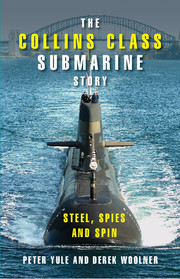Book contents
- Frontmatter
- Contents
- List of key people
- List of acronyms
- Introduction
- Part 1 You Can't Build Submarines in Australia
- 1 ‘The one class of vessel that it is impossible to build in Australia’: Australia's early submarines
- 2 Australia's Oberon class submarines
- 3 The submarine weapons update program and the origins of the new submarine project
- 4 The new submarine project
- 5 ‘We can't build submarines, go away’: Eglo Engineering and the submarine project
- 6 The acts of the apostles
- 7 ‘But how will you judge them?’: the tender evaluation process 1984–85
- 8 Spies, leaks and sackings: from tender evaluation to project definition study
- 9 The project definition study 1985–86
- 10 Debating the laws of physics: picking winners 1987
- Part 2 The Honeymoon Years 1987–92
- Part 3 ‘A Strange Sense of Unease” 1993–98
- Part 4 Resolution
- Notes
- Index
3 - The submarine weapons update program and the origins of the new submarine project
Published online by Cambridge University Press: 05 September 2013
- Frontmatter
- Contents
- List of key people
- List of acronyms
- Introduction
- Part 1 You Can't Build Submarines in Australia
- 1 ‘The one class of vessel that it is impossible to build in Australia’: Australia's early submarines
- 2 Australia's Oberon class submarines
- 3 The submarine weapons update program and the origins of the new submarine project
- 4 The new submarine project
- 5 ‘We can't build submarines, go away’: Eglo Engineering and the submarine project
- 6 The acts of the apostles
- 7 ‘But how will you judge them?’: the tender evaluation process 1984–85
- 8 Spies, leaks and sackings: from tender evaluation to project definition study
- 9 The project definition study 1985–86
- 10 Debating the laws of physics: picking winners 1987
- Part 2 The Honeymoon Years 1987–92
- Part 3 ‘A Strange Sense of Unease” 1993–98
- Part 4 Resolution
- Notes
- Index
Summary
The British Oberon submarine HMS Osiris had an affinity with the town of Ilkley in Yorkshire, which had raised the money for an earlier submarine, also called Osiris, in the Second World War. In the 1980s the patron of the Ilkley naval cadets was a highly regarded pianist. For one cadet fundraiser the submarine went to Hull and a piano was placed on it so the pianist could give a concert as they sailed down the river. However, the tides are fierce in the Humber River and following several delays the trip started with an ebb tide of 7–8 knots. The tug line parted and the submarine sailed sideways for a mile and a quarter down the Humber. It was pouring rain but the pianist kept playing, and the submarine's skipper thinks he was quite unaware of the drama or the rain. After recovering the submarine's heading they completed the transit of the Humber with no damage other than a little embarrassment.
The commanding officer was Mike Gallagher, later to be the commanding officer of HMAS Farncomb, the second of the Collins class submarines. Gallagher, like many Australian submariners before him, had successfully completed the stressful and demanding Royal Navy course for submarine commanders known as ‘Perisher’ and, again like a select few Australians, he was given command of a British conventional submarine.
- Type
- Chapter
- Information
- The Collins Class Submarine StorySteel, Spies and Spin, pp. 20 - 29Publisher: Cambridge University PressPrint publication year: 2008



